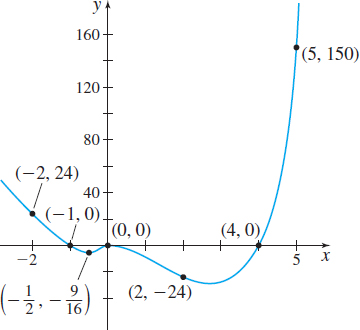EXAMPLE 1Analyzing the Graph of a Polynomial Function
For the polynomial function f(x)=x2(x−4)(x+1):
- (a) Find the x- and y-intercepts of the graph of f.
- (b) Determine whether the graph crosses or touches the x-axis at each x-intercept.
- (c) Plot at least one point to the left and right of each x-intercept and connect the points to obtain the graph.
19
Solution
- (a) The y-intercept is f(0)=0. The x-intercepts are the zeros of the function: 0, 4, and −1.
- (b) 0 is a zero of multiplicity 2; the graph of f will touch the x-axis at 0. The numbers 4 and −1 are zeros of multiplicity 1; the graph of f will cross the x-axis at 4 and −1.
- (c) Since f(−2)=24, f(−12)=−916, f(2)=−24, and f(5)=150, the points (−2,24), (−12,−916), (2,−24), and (5,150) are on the graph. See Figure 31.

